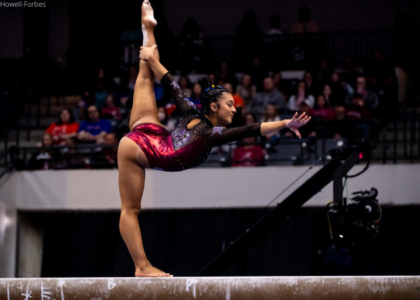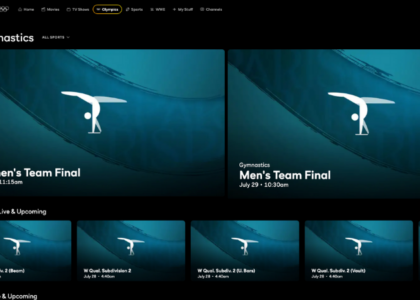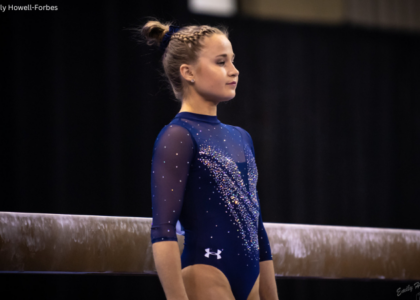While most gymnastics fans have become accustomed to seeing Ragan Smith model a leotard, there’s been a major difference for Smith when she’s participated in brand campaigns over the past year. A former USA Gymnastics all-around champion and alternate for the 2016 Olympic team, Smith has been a prominent face in the sport for many years, but like every other college athlete, has only been able to benefit from her own name, image and likeness since the NCAA’s decision to allow it starting in July 2021.
Once posing in leotard catalogs for the exposure, Smith now makes money as an ambassador for Plum Practicewear, where she’s also in the process of designing her own leo.
“It’s good to have extra money, especially for after college, and it’s really fun endorsing brands and getting myself out there more,” said Smith, who also won an NCAA championship this year with Oklahoma.
Although generally regarded as a positive change, the full impact of the NCAA’s decision to permit what it prohibited for so long remains largely unknown. Academic progress rate (APR) reports — the NCAA’s stat of choice to measure academic success — for the 2021-2022 sports year won’t be released until next summer, and an April deadline for an impact report from the governing body itself has long passed with no indication it will ever materialize.
So, one year later, how is NIL affecting college gymnastics?
The Good
Smith is just one of countless college gymnasts who have taken advantage of the NCAA’s sudden but newfound leniency toward student-athletes making money. After states began pushing for their own legislature to allow for college athletes to use their NIL, the NCAA ushered in a new era of athletics, and gymnasts were more than ready to capitalize.
Year one data from INFLCR, the content platform hundreds of universities utilize to manage their student-athlete NIL activity, shows that women’s gymnastics had the third-most reported NIL transactions of any sport amongst Power Five conference schools. That falls short of only football and men’s basketball. Gymnastics tops that same list amongst exclusively women’s sports, and also pulls in a massive average transaction value of over $7,000. For comparison, football’s average is just under $3,400.
“I told our administration and anyone who would listen over the last few years as NIL opened up that gymnasts are going to be active in this space,” said Auburn head coach Jeff Graba. “Gymnasts are active on social media, they know how to market themselves, and they’re savvy in that situation. They’re not waiting for people to come to them, they’re going out and getting things done. That’s the mentality and gymnastics mindset.”
Undoubtedly driving up the gymnastics NIL stats is one of Graba’s athletes, Sunisa Lee, who Just Women’s Sports listed as having the second-highest potential NIL value of any female athlete last fall and has been seen non-stop in ad campaigns since. Money aside, Lee’s presence as a college athlete alone can be listed as a benefit of allowing NIL. Even with American athletes winning the last five Olympic all-around titles, Lee is the first to compete sporting a leo of an NCAA program.
“We all know that Suni and some of those Olympians, maybe they don’t go to college without NIL,” said Graba. “It’s done a big favor for our sport.”
The recent influx of Olympians competing collegiately doesn’t only benefit fans and team scores, but offers well-known athletes greater opportunities to market themselves in the new NIL era. Sydney McGlone, former Arkansas gymnast and current Athlete Brand Development Coordinator for the Razorbacks’ athletic department, lists that as one of the most underrated positives for athletes stemming from this change in policy.
“In Olympic sports you get your typical four-year fans,” explained McGlone. “But by people like Suni and Jade [Carey] going to the NCAA, they get to make a name for themselves outside of just that four-year realm.”
In addition to financial gains and elevated exposure, a somewhat unexpected positive has been the opportunity for student-athletes to learn about themselves and gain new experiences. McGlone, who handles NIL for Arkansas student-athletes, says one of the most rewarding parts of her job is working with individuals to discover their own brand and having conversations about how they want to be represented. For example, McGlone recently helped Razorback gymnast Jensen Scalzo explore some NIL activities related to the sports broadcasting career she hopes to pursue upon graduation.
“Seeing them come into their own and know who they are before they’re done being a gymnast, I wish I would have known that,” McGlone said. “They’re able to develop earlier and that’s awesome.”
As a student-athlete, Smith shares a similar sentiment. She’s not only happy to be benefiting financially but is also appreciative of the flexibility she now has to find ways to learn more about herself.
“I think it’s good for us to get out there. It gives us more freedom to figure out what we like to do and what we like to sponsor and endorse,” said Smith. “Different people like to endorse different things, so it’s good to express more of what you like to do, get paid and help yourself after college with really good connections.”
The Iffy
It’s no secret that the NCAA didn’t want to allow student-athletes to earn NIL compensation — just look at the way the policy changed. Despite years of pressure mounting, the NCAA never drafted rules or guidelines for NIL, so when the day came to abruptly reverse policy, it defaulted largely to individual states and universities to govern and fend for themselves. The NCAA also continued to fight legally against student-athletes making money, racking-up nearly $38 million in legal fees to be handed a unanimous loss from the Supreme Court in the infamous Alston case.
“It’s bringing a lot of chaos,” said Graba. “It’s changing a lot quicker than people can make rules for. We’re having to be nimble and creative as to how we manage this new space of NIL.”
The NCAA’s choice to micromanage every aspect of being a college athlete apart from NIL has created a convoluted landscape where policies differ between almost every school. With no universal standards to follow, NIL education has been paramount in the new era so that the student-athletes who are supposed to benefit from this change don’t suffer consequences. Some schools, like Arkansas, have in-house staff members dedicated to giving student-athletes NIL support, some schools have outsourced that responsibility to platforms like INFLCR, and some athletes have taken it upon themselves to find a way to navigate this new territory.
“It’s important to make sure you know what you’re doing because you can get your scholarship taken away,” said Smith, who chose to hire an agent before engaging in any NIL activity. “I didn’t want to do anything until I had an agent because I didn’t want to get my eligibility taken away. I love my university and gymnastics.”
Adding NIL activity, and the necessary accompanying education, to the already hectic schedule of a student-athlete also presents its challenges. The time invested into NIL varies depending on what a student-athlete hopes to get out of the experience, but even during a lighter week, Smith has to take the time for a call to check in with her agent. With more responsibilities now in front of student-athletes as this new layer of their experience unfolds, their physical and mental well-being is more of a concern than ever.
“One thing we really tried to focus on before July 1 came was the mental health aspect, as they already have so much pressure as student-athletes and we’re seeing a trend in mental health and college athletics,” McGlone said. “So we wanted to focus on not putting so much pressure on NIL. We always tell them they’re a student first, athlete second and NIL is fun stuff.”
NIL is also making college athletes, especially gymnasts, more popular than ever. Which presents its own hurdles as well.
“Don’t Google yourself. It’s not a rule, but advice,” said Graba. “Most of my athletes have leotard contacts and that type of stuff, so I worry about their self image and body image. It’s people who are not invested in our sport that can tear them apart, and that’s the stuff that bothers me.”
Fostering good relationships with athletes has been the focus of McGlone and Arkansas to counter the potential negatives NIL can bring. And while nobody has definitively claimed that NIL has had a negative impact on grades, health or team cohesion, the concerns this new distraction can bring always seem to linger.
“As coaches, they’ve got school work, they’ve got athletics, and then you add in a third full-time job on these young people. Our worry is team dynamics and being unfocused,” said Graba. “From an administrative standpoint, it’s always a concern to make sure we have the processes in place so that we don’t have a catastrophic failure on somebody’s contract.”
What’s Changed and What’s to Come
Even with recurring concerns, the attitudes surrounding NIL have drastically improved over the course of its debut year in the NCAA. At this point to the public’s knowledge, NIL hasn’t caused any scandals or major issues with gymnastics, and that seems to be resonating with the right people.
“Everyone was super hesitant at first. I know if you talked to Jordyn [Wieber] herself she would say she didn’t know how it would affect the locker room, practices and competitions and stuff,” said McGlone. “We haven’t seen any people too distracted by NIL where it has affected their actual performance when it came competition time, and I think that has settled into coaches’ brains that it ultimately doesn’t affect how we compete.”
Student-athletes’ perspectives on NIL have changed, too. Auburn gymnasts are heavily involved with NIL, and in just the first year, Graba says he’s watched Tiger gymnasts go from being nervous to bring up the acronym to being excited to fill everybody in on what they’ve been up to. Even Oklahoma’s Smith, who missed out on earning NIL compensation her freshman and sophomore seasons, has warmed-up to the change.
“I heard about [NIL] before it came out, but I wasn’t really sure what it was or how deep it was going to get,” said Smith. “I think it was a great decision. It’s really making a positive impact on our collegiate careers as athletes.”
An NIL concern at the forefront of the ball sports world has been recruiting, an area that both Graba and McGlone don’t think has been impacted much in gymnastics yet. While “how much money can my son make” are the exaggerated first words out of any football recruit’s parents’ mouths these days, Graba believes the playing field in gymnastics has been leveled through social media exposure.
“We’re fortunate that our team is pretty visible and active in the NIL space, so it’s basically saying that if you come to Auburn you can also be active in the NIL space,” said Graba. “But there’s people everywhere doing a great job at that.”
However, McGlone thinks having an in-house NIL staff gives the Razorbacks a slight edge in recruiting, and universities creating internal positions similar to hers is one of the most forecasted long-term changes many are anticipating for NIL.
“I think we have a leg up in recruiting as the only staff really in the nation, and we don’t have to compete with anyone in our state,” said McGlone. “Obviously we’re not promising them money, but we educate them on the opportunities that are possible and that plays a big role. They know that we have a set-up here with a staff and that they’re not going to be on their own trying to figure [NIL] out on top of how to be a student-athlete.”
As we enter just the 14th month of legal NIL compensation in the NCAA, this new generation of college sports is only going to continue to change and develop. New policies will be implemented as schools fight to outdo one another in the NIL space, and programs will learn, adapt and be impacted by whatever is in store.
“I think [NIL] is going to keep growing,” said McGlone. “People were questionable about how it would affect the NCAA in general over this first year. Now, they’ve realized it’s probably one of the most important things in current college athletics.”
“I think it’s going to be a mixed bag,” said Graba. “I think the NCAA is going to have to start stepping in now that they’ve seen a year of what this looks like. But it’s going to be a net positive, especially for our sport. It has allowed Olympians to step in and allowed people to make money who have been marketable for years and were just never allowed to cash in.”
READ THIS NEXT: International Student-Athletes Are Missing out Big on NIL
Article by Brandis Heffner
Like what you see? Consider donating to support our efforts throughout the year! [wpedon id=”13158″]





All this does is open up Colleges to buy athletes. It already happens in basketball. I wouldn’t put it past Colleges like UCLA to offer money incentives to get all the Olympians to their school. Suni ended up at her college because her elite coach was the brother of Auburn’s gymnastics coach.
Now that it’s about the money, the judges have blatantly overscored the Olympians. Jade Carey has the worst form in College gymnastics and you wouldn’t know by the way she was judged. Sunisa Lee made mistakes in the AA and still ended up on the podium. UCLA hired a publicist to promote Katelyn Ohashi. Then claimed she went viral when it was all a setup by miss Val. It isn’t about the best team anymore. It’s now about bringing in money.
I am glad the girls are getting paid. This isn’t about them as individuals, it’s about the benefit they get because it brings attention and money to Colleges. Everything should be investigated.